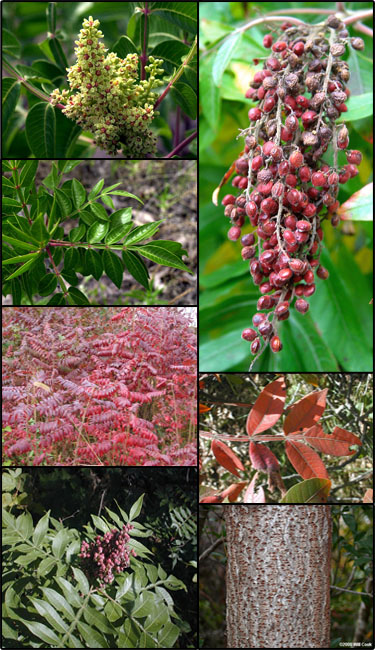Winged sumac (Rhus copallinum)
 Synonyms: Rhus copallina
Synonyms: Rhus copallinaCommon Names: Shining sumac, dwarf sumac
Description: Introduced as an ornamental. It also has medicinal uses for skin rashes, dysentery, mouth sores and sunburn. It's bark is also widely used in the tanning industry.
Habit: Perennial shrub 4-10 ft tall, 1-3 ft in diameter; young twigs and leaf stalks softly-hairy and with raised dots.
Leaves: Alternate, pinnately compound, up to 12 in long, 7-15 leaflets per leaf, leaflets are lance-shaped with entire margins, rachis has prominent wings between the leaflets, shiny, dark green above, paler and a bit fuzzy below.
Stems: Woody, medium-textured, speckled with lenticels, and covered with fine, velvety, reddish brown hair; buds are small, rounded and hairy, leaf scars horseshoe-shaped. Light brown to gray in color, smooth with numerous lenticels when young, later with large, thin scales.
Flowers: Monoecious, greenish-yellow and small, borne on 3-5 in wide, terminal pyramid-shaped panicles; blooms May through November.
Fruit and seeds: Dark red in color, round drupe borne on terminal cluster, 1/8 in long, covered with short, sticky, red hairs; matures in fall but present through winter.
Habitat: Native to United States, plant has a tendency to become weedy in nature. Found in prairies, thickets, open woods, glades, roadsides, and railroads.
Reproduction: By seed.
Similar species: Prairie sumac (Rhus lanceolata); smooth sumac (Rhus glabra); staghorn sumac (Rhus typhina); poison sumac (Toxicodendron vernix);
Monitoring and rapid response: Hand-pulling for small infestations, controlled fire, basal bark treatments; effectively controlled using any of the several readily available general use herbicides such as triclopyr (Trade name Garlon). Credits: The information provided in this factsheet was gathered from the Virginia Tech Department of Forest Resources and Environmental Conservation VTree.
Individual species images that appear with a number in a black box are courtesy of the Bugwood.org network (http://www.invasive.org).Individual photo author credits may not be included due to the small display size of the images and subsequent difficulty of reading the provided text. All other images appear courtesy of Google (http://images.google.com).
Common Name: | Winged sumac |
Scientific Name: | Rhus copallinum |
Family: | Anacardiaceae (Sumac) |
Duration: | Perennial |
Habit: | Trees |
USDA Symbol: | RHCO |
